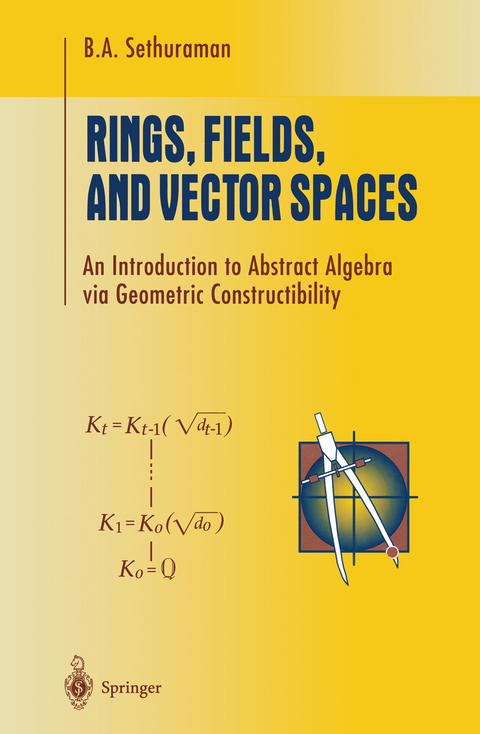Rings, Fields, and Vector Spaces
An Introduction to Abstract Algebra via Geometric Constructibility
Seiten
1996
Springer-Verlag New York Inc.
978-0-387-94848-5 (ISBN)
Springer-Verlag New York Inc.
978-0-387-94848-5 (ISBN)
It grew out of a course offered at California State University, Northridge, in our teacher preparation program, titled Foundations of Algebra, that was intended to provide an advanced perspective on high-school mathe matics. All the students in my course had taken an earlier course .
This book is an attempt to communicate to undergraduate math ematics majors my enjoyment of abstract algebra. It grew out of a course offered at California State University, Northridge, in our teacher preparation program, titled Foundations of Algebra, that was intended to provide an advanced perspective on high-school mathe matics. When I first prepared to teach this course, I needed to select a set of topics to cover. The material that I selected would clearly have to have some bearing on school-level mathematics, but at the same time would have to be substantial enough for a university-level course. It would have to be something that would give the students a perspective into abstract mathematics, a feel for the conceptual elegance and grand simplifications brought about by the study of structure. It would have to be of a kind that would enable the stu dents to develop their creative powers and their reasoning abilities. And of course, it would all have to fit into a sixteen-week semester. The choice to me was clear: we should study constructibility. The mathematics that leads to the proof of the nontrisectibility of an arbitrary angle is beautiful, it is accessible, and it is worthwhile. Every teacher of mathematics would profit from knowing it. Now that I had decided on the topic, I had to decide on how to develop it. All the students in my course had taken an earlier course . .
This book is an attempt to communicate to undergraduate math ematics majors my enjoyment of abstract algebra. It grew out of a course offered at California State University, Northridge, in our teacher preparation program, titled Foundations of Algebra, that was intended to provide an advanced perspective on high-school mathe matics. When I first prepared to teach this course, I needed to select a set of topics to cover. The material that I selected would clearly have to have some bearing on school-level mathematics, but at the same time would have to be substantial enough for a university-level course. It would have to be something that would give the students a perspective into abstract mathematics, a feel for the conceptual elegance and grand simplifications brought about by the study of structure. It would have to be of a kind that would enable the stu dents to develop their creative powers and their reasoning abilities. And of course, it would all have to fit into a sixteen-week semester. The choice to me was clear: we should study constructibility. The mathematics that leads to the proof of the nontrisectibility of an arbitrary angle is beautiful, it is accessible, and it is worthwhile. Every teacher of mathematics would profit from knowing it. Now that I had decided on the topic, I had to decide on how to develop it. All the students in my course had taken an earlier course . .
1 Divisibility in the Integers.- 2 Rings and Fields.- 3 Vector Spaces.- 4 Field Extensions.- 5 Polynomials.- 6 The Field Generated by an Element.- 7 Straightedge and Compass Constructions.- References.
| Reihe/Serie | Undergraduate Texts in Mathematics |
|---|---|
| Zusatzinfo | XIV, 192 p. |
| Verlagsort | New York, NY |
| Sprache | englisch |
| Maße | 156 x 234 mm |
| Themenwelt | Mathematik / Informatik ► Mathematik ► Algebra |
| Mathematik / Informatik ► Mathematik ► Analysis | |
| ISBN-10 | 0-387-94848-1 / 0387948481 |
| ISBN-13 | 978-0-387-94848-5 / 9780387948485 |
| Zustand | Neuware |
| Informationen gemäß Produktsicherheitsverordnung (GPSR) | |
| Haben Sie eine Frage zum Produkt? |
Mehr entdecken
aus dem Bereich
aus dem Bereich
Buch | Softcover (2022)
Springer Spektrum (Verlag)
CHF 55,95




